Customer service is the vital relationship between a company and its customers, since it helps to keep and improve the value of those customers. By delivering excellent customer service, businesses can build a loyal following that refers new customers, serves as case studies, and provides testimonials and reviews.
The invention of artificial intelligence and automation has changed the customer experience. With the help of chatbots, virtual assistants, and automated messaging, issues and requests can be easily handled.
While AI enhances efficiency and reduces costs, humans are still required for processing complex and emotional interactions. Businesses must establish a balance between artificial intelligence and human customer service to maximize both productivity and customer pleasure.
The Benefits of AI-Powered Customer Service
You should first understand what your consumers expect and desire from you.
- What type of communication do they prefer?
- Do they feel comfortable communicating with a chatbot or would they rather speak to a live person?
- How critical is it for them to receive an answer quickly?
And, by answering a few simple questions, you can determine whether AI-powered products are appropriate for serving your consumers.
Among the present AI-based customer service solutions, the following benefits stand out.
- You can personalize communication. You can utilize artificial intelligence systems that deliver personalized communication recommendations based on data analysis and consumer preferences.
- You will be able to cut down on response time. You can utilize AI assistants to minimize the user's response time, enhancing customer loyalty and happiness.
- You can save money. You can save costs by using AI solutions to automate mundane processes.
- You can easily scale it. AI-based assistance systems can increase the number of ongoing tasks, allowing businesses to extend their operations and serve consumers more efficiently and effectively.
With all this, it also retains the importance of the presence of a human in customer service.
The Importance of Human Customer Service Representatives
Customer service is critical for any company, and it takes human interaction to make customers feel heard, understood, and to establish relationships. Interacting with others allows us to exchange ideas, learn new views, and solve problems.
While AI chatbots can improve operations, they lack the emotional intelligence and interpersonal skills required for effective interaction.
Here are some examples of AI's limitations in customer service:
- Dependency on the input data: AI that is based on a customer database is dependent on its composition, quality, completeness, and accuracy. Poor data quality will result in poor service quality. AI chatbots may fail to provide a personalized customer experience due to the difficulties in responding to each client's unique situation and preferences.
- Misunderstanding due to lack of context: AI-powered support systems are sometimes unable to understand all elements of customer requests while remaining focused on the task at hand, resulting in misunderstandings and incorrect responses.
- Lack of human factor Unfortunately, artificial intelligence systems have not yet learned to recognize human sentiments and emotions. Therefore, they also cannot display empathy or respond to non-obvious signals. It may be tough to understand someone who is dissatisfied or unhappy and cannot simply articulate their problems.
- Complex problem solving: While AI excels at simple and routine activities, it may struggle with complicated or unexpected jobs. This is due to the fact that AI is based on pre-programmed rules and algorithms, which may not be capable of dealing with the intricacies of human problems, changes, or unique client wants.
Balancing Human and AI-Powered Customer Service
The application of AI in work does not imply a shift to full automation. According to "The State of Customer Care in 2022", McKinsey, 75% of businesses utilize various channels for dealing with clients. As a result, the current customer service model has evolved into omnichannel, with the company now having points of interaction with the consumer both digitally and offline.
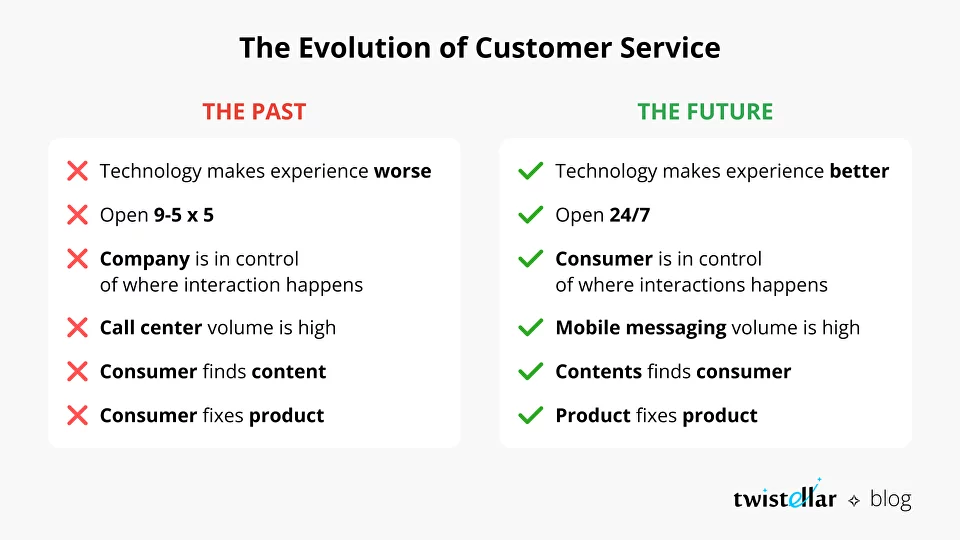
The Evolution of Customer Service
Companies have to combine their customer interaction strategy with appropriate AI-powered tools, core technology, and data to take advantage of these benefits. This new customer service approach includes everything from proactive client communication to AI-assisted solutions and post-engagement performance review.
By leveraging AI, companies can deliver proactive and personalized service, meeting customer needs even before they are expressed. This can boost customer engagement, resulting in more cross-sell and upsell opportunities, while also reducing the cost of serving customers.
In the banking industry alone, research by McKinsey in 2020 suggests that AI technologies could generate up to $1 trillion in additional value each year, with a significant portion of this coming from improved customer service.
A new AI-powered customer experience model is shown below. The process is illustrated from a client expressing a specific request through delivering AI-enabled solutions and finally performance evaluation.
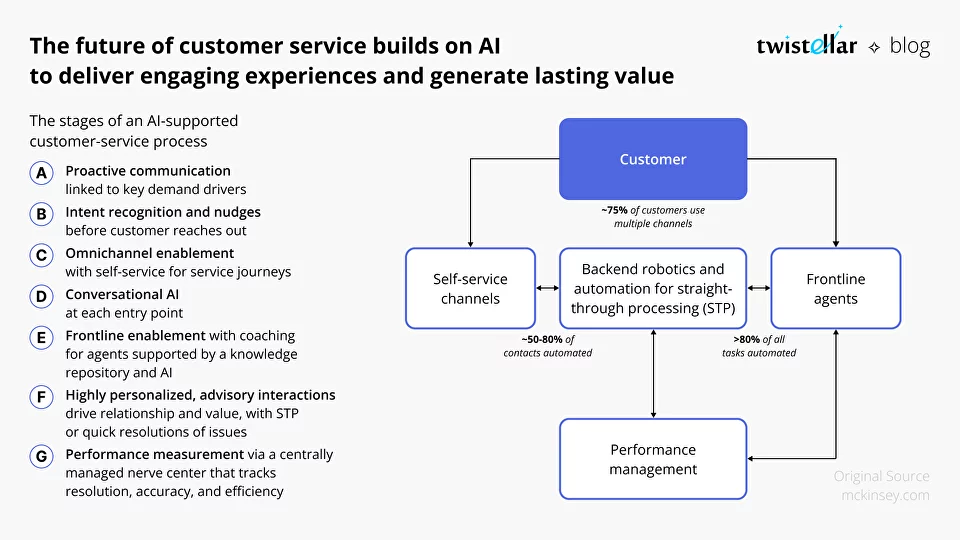
The Future of Customer Service Builds on AI
As technology advances, customer service representatives will take on more important tasks that require deep knowledge, understanding of all aspects of their company and product ecosystem.
With the help of self-service technologies and artificial intelligence, representatives will have more time to genuinely interact with customers, building trust through meaningful conversations about reviews and unique product features.
Representatives will be able to contribute to the development of the quality of service, for example, they will be able to attract customers in an unusual manner and improve the quality of service by testing content and improving chatbots.
How Is AI Used in Customer Service?
Artificial intelligence has an almost infinite number of possible uses in contact centers, eCommerce platforms, and sales phases. The application of AI in customer service is growing at a quick rate. Let's explore some of the ways to make use of AI in customer service and how they might aid businesses in enhancing the client experience:
1. Chatbots. Chatbots that are powered by AI may respond to consumer enquiries right away without a human being becoming involved, 24/7. This can speed up response times and boost customer satisfaction while saving organizations time and resources.
Chatbots can also function as self-service software, which enables consumers to solve problems, make transactions without requiring human assistance.
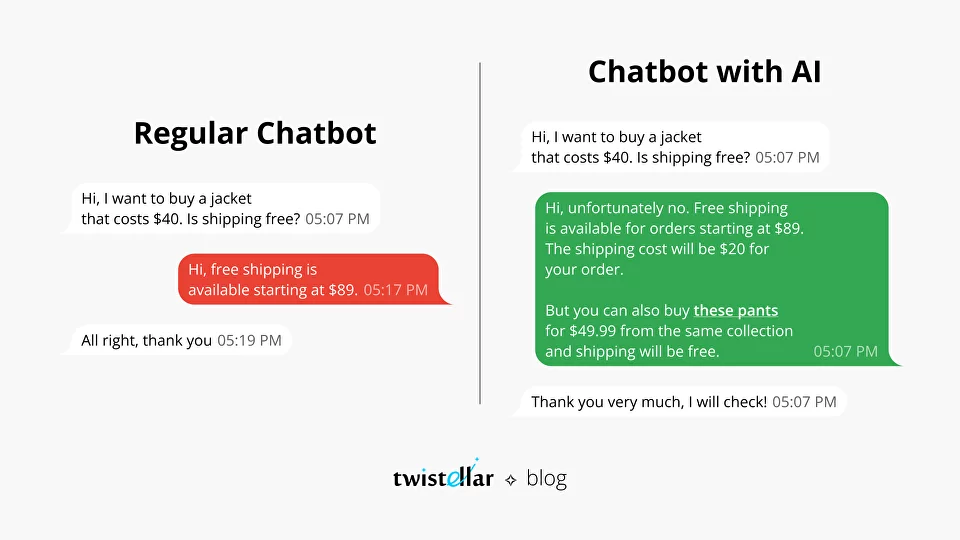
Regular Chatbot vs. Chatbot with AI
Chatbots are widely used at the same time as human personal customer service.
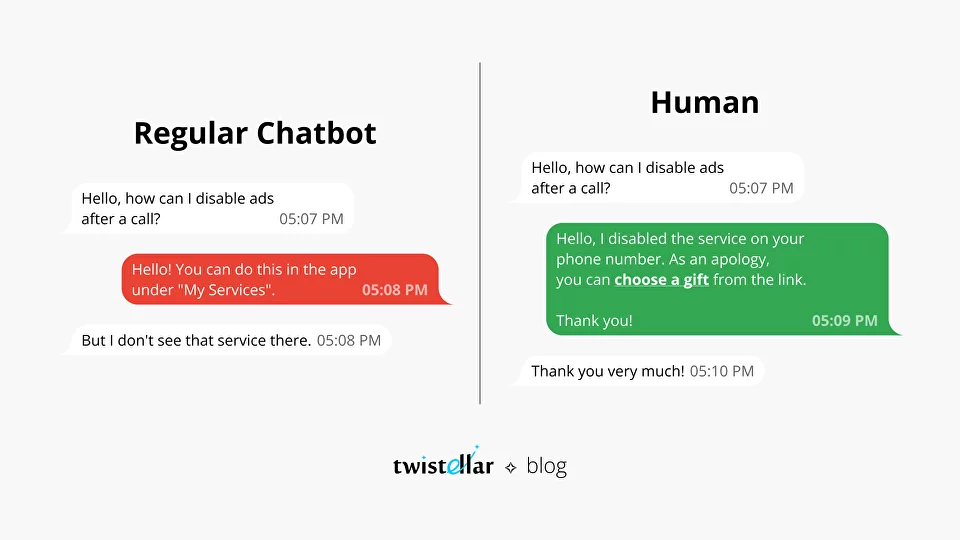
Regular Chatbot vs. Human
2. Natural Language Processing: NLP enables transcribing communication across several channels and then analyzing the data to improve overall customer experience. For instance, Natural Language Search, which allows users to find information by utilising everyday language rather than precise keywords or phrases. Language translation, auto-correction, email filters, translators (e.g. Google Translate) are also NLP and more.
3. Machine Learning: It's a system for analysing large amounts of data and gaining meaningful insights from them. Machine learning is used by contact center solutions, such as Salesforce Service Cloud Voice. It gives AI-based insights for an improved phone-based service experience.
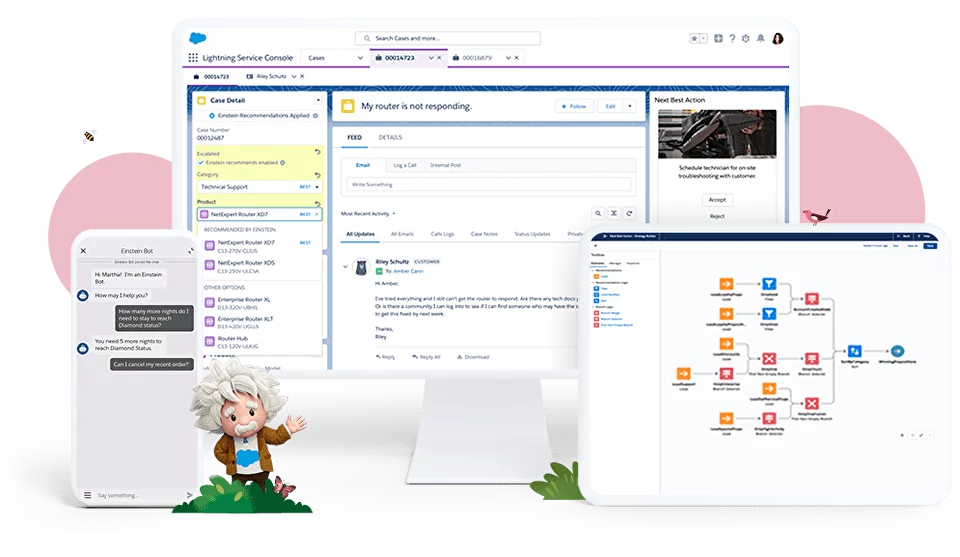
Artificial Intelligence in Salesforce Service Cloud
4. Dynamic pricing. Dynamic Pricing using AI-powered predictive analytics involves adjusting prices in real time based on market demand, inventory levels, and other factors. AI algorithms can analyze real-time data to forecast demand, identify pricing trends, and adjust prices in real time.
For example, Uber uses the same technology. Uber's pricing model uses real-time user demand and driver availability data to dynamically adjust fares. When demand is high, algorithms predict the level of demand and adjust fares upwards to encourage more drivers to connect to work and offer rides.
The quantity of products available on the market nowadays is dizzying, and every organization may find something to meet their requirements.
The incorporation of AI-powered customer service solutions has the potential to transform how organizations interact with their customers. However, keep in mind that AI is not a replacement for human contact, but rather a tool to enhance it.
Businesses should carefully assess their customer service requirements and determine where AI can be most helpful, such as in managing repetitive jobs or responding quickly to simple enquiries. Simultaneously, organizations should prioritize human engagement in more complex or emotionally charged circumstances when empathy and personalized attention are essential.
Finally, the success of any customer service plan is determined by striking the proper balance between technology and human touch.











Responses